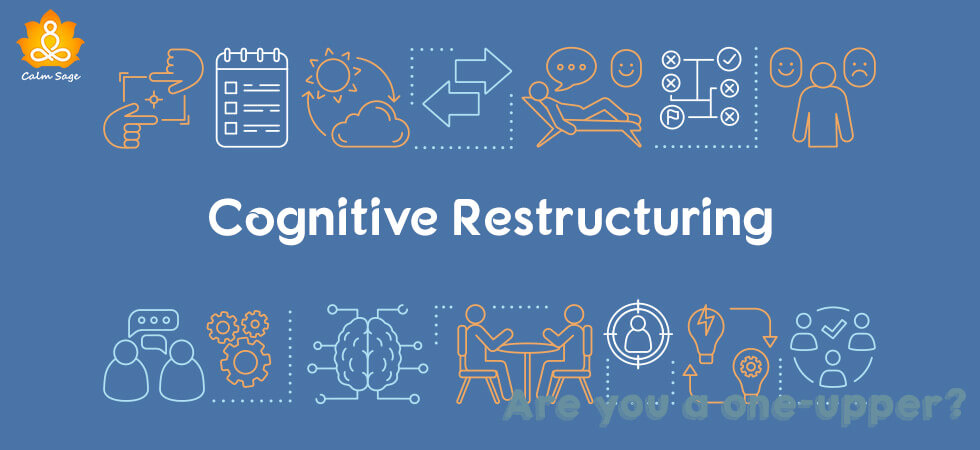Cognitive Restructuring: Definition, Techniques And Much More

List of Contents
Cognitive restructuring is best for all those who struggle with intense negative emotions, thoughts and feelings. Most of us are troubled by our negative thoughts and feelings but some of us are highly bothered by them.
Cognitive restructuring techniques can be very, very helpful for all those who fail to negate their negative thoughts. You can use these techniques and strategies to make your life a lot better. Nobody wants to live with negativity, especially when it comes from within.
Cognitive restructuring can be used in cognitive behavioral therapy to help patients switch their neural pathways from negative to positive. Let me help you get a better understanding of cognitive restructuring and its techniques….
What Is The Meaning Of Cognitive Restructuring?

Cognitive restructuring is a process which involves identifying the negative and irrational thoughts and feelings and then reframing them to reverse the effect of negative thoughts and emotions.
Irrational thinking can do a lot more damage than you and I know off. These irrational negative thoughts are called cognitive distortion. Most of the intensity of most psychological issues can be reduced by reducing the negative thought pattern.
Do you wish to read more about the meaning and definition of cognitive restructuring? Click here!
Let’s look at the strategies used by cognitive restructuring methods….
Cognitive Restructuring Strategy…
The strategy used by the therapist during cognitive restructuring is to divide the entire process in two halfs. The first half is all about identifying the negative thoughts and the second half deals with reframing the negative thoughts.
- Identifying irrational thoughts
- Psychoeducation
- Thought awareness
- Thought record
- Cognitive reframing
- Socratic questioning
- Decatastrophizing
- Gather evidence for thought trail
- Find alternates
These are the steps and techniques that can be used in cognitive restructuring. Let’s understand them in detail…
Also read: Want To Reduce Negative Thoughts? Try This Exercise To Stop Negative Thinking
Steps For Cognitive Restructuring
There are four steps for cognitive restructuring. All these steps will help you identify your negative thoughts, irrational thoughts and the core belief that makes you have such thoughts and feelings.
Step 1
Psychoeducation: having knowledge about your condition is very important. It is your therapist’s duty to educate you about cognitive distortions and how it can influence your thoughts, emotions and feelings.
Step 2
Thought awareness: after you have gained enough knowledge about cognitive model and distortion, it’s time for you to build awareness of your thoughts. Increase your awareness! Stop and think about why you are feeling this way. Where is this thought coming from? What was the trigger?
Step 3
Thought record: keeping a record of your thoughts can be very helpful in identifying and understanding the irrational negative thoughts. Take it as an exercise, write down about your experience and how it made you feel. It’s going to make things much clearer for you.
Also read: How to Control Negative Thoughts – Top 15 Ways to Stop
Step 4
Cognitive restructuring: this is the last step to complete the entire process. All the negative thoughts that you have identified by now will be restructured with the help of cognitive restructuring techniques.
Techniques Used In Cognitive Restructuring
1. Socrates questioning
Socrates’ questioning has come from Greek philosophy. In this technique all you have to do is question your negative thoughts and feelings. Once you have identified the negative thoughts, ask yourself, Is it real? Am I reacting to fact or fiction?
Simply question your thoughts, trust me it will help you reframe your negative thoughts.
2. Decatastrophizing
Catastrophizing reality is a type of cognitive distortion. Sometimes the reality isn’t as harsh as you must have catastrophize it to be. Here you have to break down the situation in simpler form and see is it really that horrific or deadly?
Sit back and think about it. Remove all the extra baggage that you have attached to the situation.
Also read: How to Deal with Your Negative Thoughts? 5 Easy Ways to Overcome Them
3. Gather evidence for thought trail
This technique of cognitive restructuring is more of an exercise. You have to put your thoughts on a trail, just like defaulters are tried in court. The catch here is that you are the prosecutor as well as the defense attorney.
First you will present the case in favor of your negative thoughts and then against your negative thoughts. By the end of this exercise you will know the result.
4. Find alternative
This technique deals with finding possible alternate responses to certain triggers. Since you already have identified your negative thoughts, it’s time for you to look for alternate thoughts. Replace your negative thoughts with positive or relational thoughts.
All these four techniques can help you get away with your negative thoughts and feelings. The cognitive distortion that has been pestering you for so long will no longer trouble you if you choose to go for cognitive restructuring.
What Are The Benefits Of Cognitive Restructuring You Ask?
There is no need for me to tell you about the benefits of not having negative thoughts bother you. Anyway, here are a few benefits listed below that are all because of cognitive restructuring…
- Manages stress
- Reduces anxiety
- Improves communication
- Helps in maintaining good relationships
- Increases self-confidence and self esteem
- Reduces the use of unhealthy coping mechanisms
Also read: 10 Amazing Ways To Control Your Thoughts And Change Your Mindset
That’s all for cognitive restructuring and its strategies, steps and techniques. Cognitive restructuring techniques can help you a lot in getting rid of the negative thoughts. Share this blog with people you think require cognitive restructuring.
I hope you found this blog interesting and helpful. Do comment and let me know if you wish to read about more such topics.
Thanks for reading.
Take care and be aware of your thoughts!




















